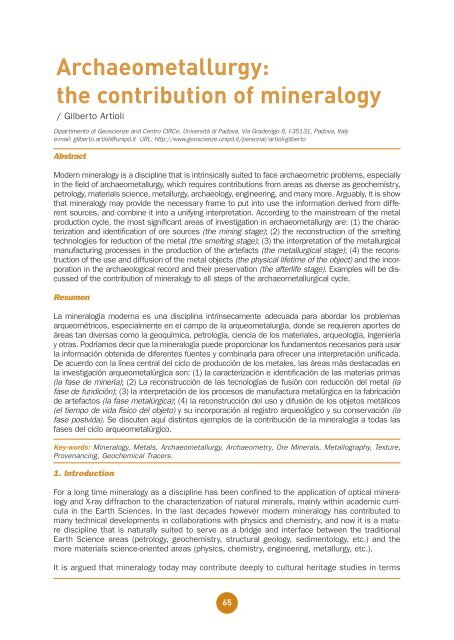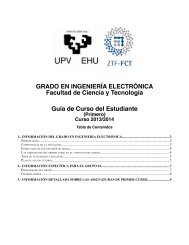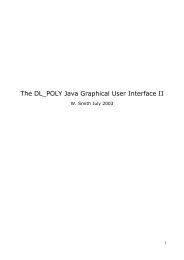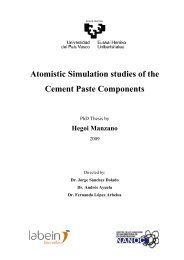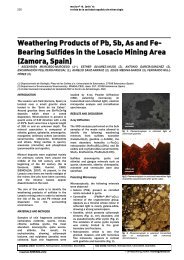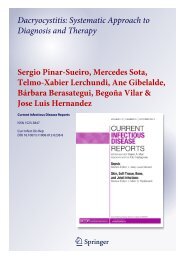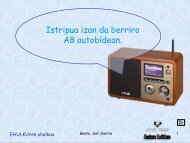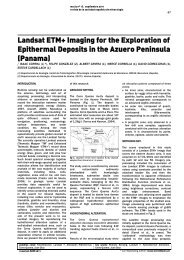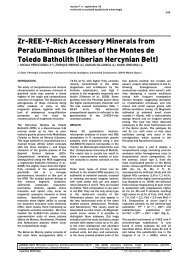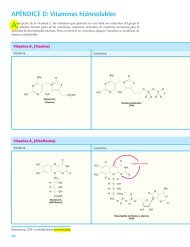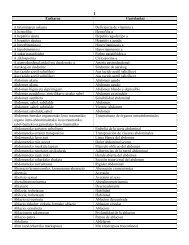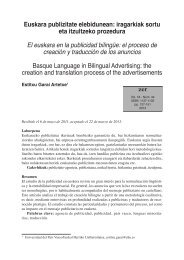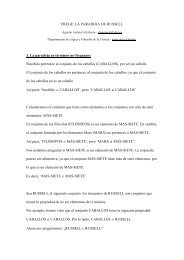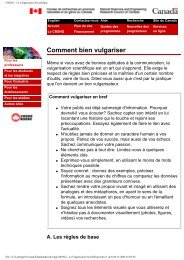Archaeometallurgy: the contribution of mineralogy
Archaeometallurgy: the contribution of mineralogy
Archaeometallurgy: the contribution of mineralogy
Create successful ePaper yourself
Turn your PDF publications into a flip-book with our unique Google optimized e-Paper software.
<strong>Archaeometallurgy</strong>:<br />
<strong>the</strong> <strong>contribution</strong> <strong>of</strong> <strong>mineralogy</strong><br />
/ Gilberto Artioli<br />
Dipartimento di Geoscienze and Centro CIRCe, Università di Padova. Via Gradenigo 6, I-35131, Padova, Italy<br />
e-mail: gilberto.artioli@unipd.it URL: http://www.geoscienze.unipd.it/personal/artioli-gilberto<br />
Abstract<br />
Modern <strong>mineralogy</strong> is a discipline that is intrinsically suited to face archaeometric problems, especially<br />
in <strong>the</strong> field <strong>of</strong> archaeometallurgy, which requires <strong>contribution</strong>s from areas as diverse as geochemistry,<br />
petrology, materials science, metallurgy, archaeology, engineering, and many more. Arguably, it is show<br />
that <strong>mineralogy</strong> may provide <strong>the</strong> necessary frame to put into use <strong>the</strong> information derived from different<br />
sources, and combine it into a unifying interpretation. According to <strong>the</strong> mainstream <strong>of</strong> <strong>the</strong> metal<br />
production cycle, <strong>the</strong> most significant areas <strong>of</strong> investigation in archaeometallurgy are: (1) <strong>the</strong> characterization<br />
and identification <strong>of</strong> ore sources (<strong>the</strong> mining stage); (2) <strong>the</strong> reconstruction <strong>of</strong> <strong>the</strong> smelting<br />
technologies for reduction <strong>of</strong> <strong>the</strong> metal (<strong>the</strong> smelting stage); (3) <strong>the</strong> interpretation <strong>of</strong> <strong>the</strong> metallurgical<br />
manufacturing processes in <strong>the</strong> production <strong>of</strong> <strong>the</strong> artefacts (<strong>the</strong> metallurgical stage); (4) <strong>the</strong> reconstruction<br />
<strong>of</strong> <strong>the</strong> use and diffusion <strong>of</strong> <strong>the</strong> metal objects (<strong>the</strong> physical lifetime <strong>of</strong> <strong>the</strong> object) and <strong>the</strong> incorporation<br />
in <strong>the</strong> archaeological record and <strong>the</strong>ir preservation (<strong>the</strong> afterlife stage). Examples will be discussed<br />
<strong>of</strong> <strong>the</strong> <strong>contribution</strong> <strong>of</strong> <strong>mineralogy</strong> to all steps <strong>of</strong> <strong>the</strong> archaeometallurgical cycle.<br />
Resumen<br />
La mineralogía moderna es una disciplina intrínsecamente adecuada para abordar los problemas<br />
arqueométricos, especialmente en el campo de la arqueometalurgia, donde se requieren aportes de<br />
áreas tan diversas como la geoquímica, petrología, ciencia de los materiales, arqueología, ingeniería<br />
y otras. Podríamos decir que la mineralogía puede proporcionar los fundamentos necesarios para usar<br />
la información obtenida de diferentes fuentes y combinarla para <strong>of</strong>recer una interpretación unificada.<br />
De acuerdo con la línea central del ciclo de producción de los metales, las áreas más destacadas en<br />
la investigación arqueometalúrgica son: (1) la caracterización e identificación de las materias primas<br />
(la fase de minería); (2) La reconstrucción de las tecnologías de fusión con reducción del metal (la<br />
fase de fundición); (3) la interpretación de los procesos de manufactura metalúrgica en la fabricación<br />
de artefactos (la fase metalúrgica); (4) la reconstrucción del uso y difusión de los objetos metálicos<br />
(el tiempo de vida físico del objeto) y su incorporación al registro arqueológico y su conservación (la<br />
fase postvida). Se discuten aquí distintos ejemplos de la contribución de la mineralogía a todas las<br />
fases del ciclo arqueometalúrgico.<br />
Key-words: Mineralogy, Metals, <strong>Archaeometallurgy</strong>, Archaeometry, Ore Minerals, Metallography, Texture,<br />
Provenancing, Geochemical Tracers.<br />
1. Introduction<br />
For a long time <strong>mineralogy</strong> as a discipline has been confined to <strong>the</strong> application <strong>of</strong> optical <strong>mineralogy</strong><br />
and X-ray diffraction to <strong>the</strong> characterization <strong>of</strong> natural minerals, mainly within academic curricula<br />
in <strong>the</strong> Earth Sciences. In <strong>the</strong> last decades however modern <strong>mineralogy</strong> has contributed to<br />
many technical developments in collaborations with physics and chemistry, and now it is a mature<br />
discipline that is naturally suited to serve as a bridge and interface between <strong>the</strong> traditional<br />
Earth Science areas (petrology, geochemistry, structural geology, sedimentology, etc.) and <strong>the</strong><br />
more materials science-oriented areas (physics, chemistry, engineering, metallurgy, etc.).<br />
It is argued that <strong>mineralogy</strong> today may contribute deeply to cultural heritage studies in terms<br />
65
<strong>of</strong> thorough knowledge <strong>of</strong> materials and optimization<br />
<strong>of</strong> investigation techniques (Artioli<br />
2010a, Artioli and Angelini 2011). Being a<br />
truly interdisciplinary science, <strong>mineralogy</strong> <strong>the</strong>refore<br />
may well form a strong foundation for<br />
scientists working with cultural heritage materials,<br />
especially in <strong>the</strong> area <strong>of</strong> archeometallurgy.<br />
As a matter <strong>of</strong> fact <strong>mineralogy</strong> naturally deals<br />
with complex mineral systems most <strong>of</strong>ten composed<br />
<strong>of</strong> a large number <strong>of</strong> chemical elements<br />
and several crystal-chemical phases, it has<br />
solid roots on crystallography and <strong>the</strong> atomic<br />
structure <strong>of</strong> matter, and it is technically and<br />
conceptually equipped to face <strong>the</strong> methodological<br />
and experimental challenges involved in <strong>the</strong><br />
technical analysis <strong>of</strong> complex materials, and in<br />
<strong>the</strong> interpretation <strong>of</strong> <strong>the</strong> processes acting upon<br />
<strong>the</strong>m (Fig. 1). Therefore <strong>mineralogy</strong> may well be<br />
<strong>the</strong> discipline possessing an adequate balance<br />
<strong>of</strong> <strong>the</strong> interdisciplinary knowledge required to<br />
face archeometallurgical problems (Artioli<br />
2010b: pp 305-348).<br />
2. <strong>Archaeometallurgy</strong><br />
Pure and alloyed metals played a major role<br />
in <strong>the</strong> technological evolution <strong>of</strong> mankind (Fig.<br />
2). It is indeed not surprising that post-<br />
Neolithic archeological periods are mostly<br />
defined on <strong>the</strong> basis <strong>of</strong> <strong>the</strong> metal technology:<br />
66<br />
<strong>Archaeometallurgy</strong>: <strong>the</strong> <strong>contribution</strong> <strong>of</strong> <strong>mineralogy</strong><br />
Gilberto Artioli<br />
Copper Age (i.e. Chalcolithic, Eneolithic),<br />
Bronze Age, and Iron Age. To <strong>the</strong>se we may<br />
well add <strong>the</strong> Steel Age, dominating technology<br />
and production after <strong>the</strong> industrial revolution.<br />
We are now in a period <strong>of</strong> extensive<br />
recycling and use <strong>of</strong> advanced alloy composites<br />
(Ashby 1987 & 2001).<br />
<strong>Archaeometallurgy</strong> deals with all aspects <strong>of</strong><br />
metal production, distribution and usage in<br />
<strong>the</strong> history <strong>of</strong> mankind (Fig. 3, Rehren and<br />
Pernicka 2008). To date <strong>the</strong> vast majority <strong>of</strong><br />
archaeometallurgical investigations deal with<br />
<strong>the</strong> early part <strong>of</strong> <strong>the</strong> use <strong>of</strong> metals (i.e. up to<br />
<strong>the</strong> 2 nd millennium BC), which include <strong>the</strong><br />
technological use <strong>of</strong> a limited numbers <strong>of</strong><br />
metallic elements (Cu, Pb, Au, Ag, Sn, Fe)<br />
and <strong>the</strong>ir alloys: mostly copper-based binary<br />
and ternary alloys (bronzes and brass: Cu-Sb,<br />
Cu-As, Cu-Sn, Cu-Zn, Cu-Sn-Pb, Cu-Sn-Zn), silver-based<br />
alloys (Ag-Cu, Ag-Au), and pewter<br />
(Sn-Pb) (Table 3.14 in Artioli 2010 summarizes<br />
<strong>the</strong> approximate time and place <strong>of</strong> introduction<br />
<strong>of</strong> <strong>the</strong> different metals and alloys in<br />
<strong>the</strong> past).<br />
However, <strong>the</strong> archaeometallurgical aspects<br />
concerning <strong>the</strong> introduction <strong>of</strong> Fe and its<br />
alloys (steel: Fe-C, Fe-C-P, etc.) and <strong>the</strong> subsequent<br />
use <strong>of</strong> all o<strong>the</strong>r known metals are<br />
equally fascinating. The recent paper by<br />
Bourgarit and Plateau (2007) dealing with<br />
Fig. 1. The schematic diagram <strong>of</strong> some <strong>of</strong> <strong>the</strong> disciplines and knowhow forming <strong>the</strong> backbone <strong>of</strong> modern <strong>mineralogy</strong> (modified from Artioli and<br />
Angelini 2011.
Seminario SEM 09 Depósito legal: CA-602-2004 / ISSN: 1698-5478<br />
<strong>the</strong> early use <strong>of</strong> Al and <strong>the</strong> possibility to distinguish<br />
<strong>the</strong> later electrolytic production<br />
from <strong>the</strong> early chemical reduction is a nice<br />
examples <strong>of</strong> <strong>the</strong> problems and techniques<br />
involved in modern archaeometallurgical<br />
67<br />
analysis.<br />
A shortlist <strong>of</strong> reference textbooks and monographs<br />
is listed at <strong>the</strong> end <strong>of</strong> <strong>the</strong> paper as an<br />
introductory aid to archaeometallurgy.<br />
Fig. 2. Relative importance <strong>of</strong> <strong>the</strong> use <strong>of</strong> materials through <strong>the</strong> prehistory and history <strong>of</strong> mankind following Ashby (1987, 2005).<br />
Fig. 3. The archaeometallurgical cycle (from Rehren and Pernicka 2008).
3. The <strong>contribution</strong> <strong>of</strong> <strong>mineralogy</strong> to<br />
archeometallurgy<br />
Based on <strong>the</strong> schematic diagram shown in<br />
Fig. 3, we may distinguish several steps in<br />
<strong>the</strong> production and life cycle <strong>of</strong> metallic<br />
objects. The examples below are intended to<br />
show <strong>the</strong> <strong>contribution</strong> <strong>of</strong> <strong>mineralogy</strong> to <strong>the</strong><br />
characterization and to <strong>the</strong> archaeometallurgical<br />
interpretation <strong>of</strong> <strong>the</strong> materials pertaining<br />
to some <strong>of</strong> <strong>the</strong> major stages <strong>of</strong> <strong>the</strong> cycle.<br />
3.1. The mining stage: ore extraction and<br />
provenancing<br />
Our knowledge on mining and ore treatment<br />
in historical times has <strong>the</strong> support <strong>of</strong> written<br />
sources, oral accounts, toponyms and family<br />
names, and even direct evidence <strong>of</strong> galleries,<br />
mine surveys and maps, treatment plants,<br />
written records <strong>of</strong> production and trades, and<br />
<strong>the</strong> like. However, <strong>the</strong> more we venture into<br />
<strong>the</strong> past <strong>the</strong> more <strong>the</strong> evidence is confused<br />
and fragmentary.<br />
When we deal with prehistory, <strong>the</strong>re are no<br />
direct sources <strong>of</strong> information, and <strong>the</strong> material<br />
evidence is scarce and very <strong>of</strong>ten contaminated<br />
or altered by successive exploitation<br />
in late periods. Therefore <strong>the</strong> investigation <strong>of</strong><br />
prehistoric archaeometallurgy is a fascinating<br />
and challenging task, aimed to reconstruct<br />
<strong>the</strong> links between ore deposits, mining activities,<br />
ore treatment, and metallurgical sites.<br />
One <strong>of</strong> <strong>the</strong> major problems is that <strong>the</strong> available<br />
pieces <strong>of</strong> archaeological evidence (prehistoric<br />
mines, roasting and smelting sites, technical<br />
ceramics, smelting slags, furnaces, crucibles,<br />
raw metal ingots) are almost never found in <strong>the</strong><br />
same site: <strong>the</strong>re are lots <strong>of</strong> pieces in <strong>the</strong> puzzle,<br />
though <strong>the</strong>re is hardly a complete image. In<br />
<strong>the</strong> most general case it is virtually impossible<br />
to complete all aspects <strong>of</strong> <strong>the</strong> investigation for<br />
an individual site or area, simply because <strong>of</strong><br />
time, cost, and record biases.<br />
Only a few extensive long-term projects come<br />
close to delineating all <strong>the</strong> major features <strong>of</strong><br />
<strong>the</strong> metallurgical chain in a geographical<br />
area, from <strong>the</strong> mine survey to <strong>the</strong> production<br />
and diffusion <strong>of</strong> metal. These are <strong>the</strong> cases<br />
<strong>of</strong> <strong>the</strong> prehistoric copper extraction in <strong>the</strong><br />
68<br />
<strong>Archaeometallurgy</strong>: <strong>the</strong> <strong>contribution</strong> <strong>of</strong> <strong>mineralogy</strong><br />
Gilberto Artioli<br />
Arabah (Timna and Faynan) region in <strong>the</strong><br />
Near East where, over thirty years, long projects<br />
have investigated and detailed out all<br />
available evidence at different levels<br />
(Ro<strong>the</strong>nberg and Merkel 1995, Ro<strong>the</strong>nberg<br />
1999, Weisgerber 2003, Hauptmann 2007),<br />
reaching a sound and complete interpretation<br />
<strong>of</strong> <strong>the</strong> regional archaeometallurgy.<br />
A recent long term project is <strong>the</strong> HiMAT one<br />
(www.uibk.ac.at/himat/), aimed to investigate<br />
<strong>the</strong> history <strong>of</strong> mining activities in <strong>the</strong> Tyrol<br />
and adjacent areas, with impact on environment<br />
and human societies (Tropper and<br />
Vavtar 2009, Schibler et al. 2011).<br />
In general, <strong>the</strong> main questions involved in <strong>the</strong><br />
investigation <strong>of</strong> prehistoric metal extraction<br />
sites are:<br />
(1) what metal was extracted and what was<br />
<strong>the</strong> nature <strong>of</strong> <strong>the</strong> mineral charge?<br />
(2) can we trace <strong>the</strong> provenance <strong>of</strong> <strong>the</strong> smelted<br />
or treated ore minerals?<br />
(3) when did <strong>the</strong> extraction activity started<br />
and how long did it last? and<br />
(4) what was <strong>the</strong> technology for metal extraction<br />
from <strong>the</strong> ores?<br />
The answers <strong>of</strong>ten require investigations at<br />
very different scales: from <strong>the</strong> submicron<br />
scale <strong>of</strong> segregations and impurities in<br />
metals and slags, to <strong>the</strong> large geographic<br />
scale <strong>of</strong> <strong>the</strong> regional distribution <strong>of</strong> ore deposits<br />
and metal objects.<br />
As an example, many <strong>of</strong> <strong>the</strong>se questions concerning<br />
<strong>the</strong> rise and development <strong>of</strong> copper<br />
mining and metallurgy in <strong>the</strong> Alpine area<br />
from <strong>the</strong> end <strong>of</strong> <strong>the</strong> Neolithic (approx. in <strong>the</strong><br />
5 th millennium BC) to <strong>the</strong> end <strong>of</strong> <strong>the</strong> Bronze<br />
Age (approx. <strong>the</strong> beginning <strong>of</strong> <strong>the</strong> 1 st millennium<br />
BC) are still unanswered.<br />
Our knowledge before <strong>the</strong> Iron Age is very<br />
fragmentary and we are confronted for example<br />
with mines showing early exploitation but<br />
little or no evidence <strong>of</strong> reduction slags (i.e.<br />
Libiola and Monte Loreto, Ligurian Alps, Italy:<br />
Maggi and Pearce 1998; Saint Véran,<br />
Queyras, France: Bourgarit et al. 2008,<br />
2010), or with several smelting sites where a<br />
substantial amount <strong>of</strong> slags have been
Seminario SEM 09 Depósito legal: CA-602-2004 / ISSN: 1698-5478<br />
found, but <strong>the</strong>y show no straightforward connection<br />
with <strong>the</strong> ore deposits (i.e. Luserna,<br />
Trentino: Nicolis et al. 2007; Renon, Alto<br />
Adige).<br />
One fur<strong>the</strong>r paradox is that <strong>the</strong>re was abundant<br />
metal circulating since at least <strong>the</strong> 4 th<br />
millennium BC, as exemplified by <strong>the</strong> Iceman<br />
copper axe (approx. 3200 BC: Fleckinger<br />
2007) and a number <strong>of</strong> coeval artefacts, but<br />
<strong>the</strong>re is no clear evidence <strong>of</strong> large scale<br />
mining or smelting until half a millennium<br />
later. The only earlier recognized smelting<br />
sites are small scale metallurgical activities<br />
confined to <strong>the</strong> Brixlegg site, in Tyrol<br />
(Höppner et al. 2005) and Belovode, Serbia<br />
(Radivojevic et al. 2010). Several sites with<br />
Chalcolithic slags are known in <strong>the</strong> Eastern<br />
Alps (Artioli et al. 2007) although <strong>the</strong>y mostly<br />
date to <strong>the</strong> mid 3 rd century BC or later. They<br />
apparently indicate a sizeable mass copper<br />
production only towards <strong>the</strong> latter part <strong>of</strong> <strong>the</strong><br />
Alpine Copper Age.<br />
In <strong>the</strong> last few years a long-term project focused<br />
on prehistoric Alpine copper metallurgy<br />
(AAcP, Alpine Archaeocopper Project:<br />
http://www.geoscienze.unipd.it/aacp/welcome.html)<br />
was launched in order to investigate<br />
in detail <strong>the</strong> relationship between ores,<br />
slags, and metal in <strong>the</strong> area. The core <strong>of</strong> <strong>the</strong><br />
project is <strong>the</strong> development <strong>of</strong> an extensive<br />
database <strong>of</strong> Alpine copper mines containing<br />
mineralogical, petrological, chemical, isotopic,<br />
and genetic information on <strong>the</strong> ore deposits<br />
(Artioli et al. 2008a).<br />
Solid minerogenetic interpretation <strong>of</strong> <strong>the</strong><br />
deposits (Nimis et al. 2012) and advanced<br />
statistical analysis <strong>of</strong> <strong>the</strong> ore chemical and<br />
isotopic data is <strong>the</strong> basis to understand <strong>the</strong><br />
applicability <strong>of</strong> <strong>the</strong> measured geochemical<br />
tracers (Pb and Cu isotopic ratios, nearly 60<br />
minor and trace elements, including REE elements)<br />
to metallurgical processes, including<br />
slagging and reduction smelting. The discriminant<br />
analysis developed on <strong>the</strong> copper ore<br />
database was tested on <strong>the</strong> well-characterized<br />
area <strong>of</strong> Agordo, Alpi Bellunesi, Veneto,<br />
whose Valle Imperina copper mine was <strong>the</strong><br />
principal source <strong>of</strong> copper for <strong>the</strong> Republic <strong>of</strong><br />
Venice. The results <strong>of</strong> <strong>the</strong> Agordo case study<br />
indicate that <strong>the</strong> developed discriminant<br />
69<br />
models can be applied to <strong>the</strong> smelting slags<br />
and to <strong>the</strong> unalloyed raw copper extracted<br />
from <strong>the</strong> ores (Artioli et al. 2008b).<br />
Application <strong>of</strong> <strong>the</strong> tracing models to <strong>the</strong><br />
manufactured objects requires a careful chemical<br />
and metallographic examination <strong>of</strong> <strong>the</strong><br />
metal, in order to understand <strong>the</strong> nature <strong>of</strong><br />
<strong>the</strong> alloy, <strong>the</strong> presence <strong>of</strong> remnants <strong>of</strong> <strong>the</strong> original<br />
charge as inclusions and segregations,<br />
and possible biases due to alteration or contamination.<br />
It may indeed be dangerous to<br />
pursue separately <strong>the</strong> investigation <strong>of</strong> <strong>the</strong><br />
ores, <strong>of</strong> <strong>the</strong> slags, and <strong>of</strong> <strong>the</strong> metal objects:<br />
strict synergy is needed to understand <strong>the</strong><br />
complexity <strong>of</strong> <strong>the</strong> metallurgical cycle.<br />
Recent applications <strong>of</strong> <strong>the</strong> models based on<br />
<strong>the</strong> database <strong>of</strong> geochemical tracers have<br />
met some success in<br />
• firmly locating in <strong>the</strong> Monte Fondoli area<br />
(Pfunderer Bergwerk, Chiusa, Alto Adige)<br />
<strong>the</strong> source <strong>of</strong> <strong>the</strong> copper ores used for all<br />
known Chalcolithic smelting slags in <strong>the</strong><br />
Brixen area (Millan, Gudon,<br />
Circonvallazione Ovest: Angelini et al.<br />
2012), and<br />
• identifying <strong>the</strong> source <strong>of</strong> <strong>the</strong> ores used for<br />
<strong>the</strong> production <strong>of</strong> <strong>the</strong> Late Bronze Age<br />
objects found in <strong>the</strong> Monte Cavanero<br />
hoard (Chiusa di Pesio, Cuneo, Western<br />
Alps: Artioli et al. 2009).<br />
These examples highlight <strong>the</strong> patient work <strong>of</strong><br />
<strong>the</strong> mineralogist in provenancing studies, that<br />
is to critically filter <strong>the</strong> geological, geochemical,<br />
mineralogical, and archaeological information<br />
into a consistent and unifying interpretation.<br />
Key issues to be discussed are:<br />
(1) <strong>the</strong> development, consistency, and dataretrieval<br />
protocols <strong>of</strong> geochemical and<br />
isotopic databases;<br />
(2) <strong>the</strong> availability <strong>of</strong> chemical and isotopic<br />
databases for different ore deposits; and<br />
(3) <strong>the</strong> mineralogical, geochemical and statistical<br />
significance <strong>of</strong> <strong>the</strong> chemical and isotopic<br />
tracers used for provenance discrimination.
3.2. The smelting stage: metal production<br />
Our knowledge concerning <strong>the</strong> ancient extraction<br />
processes <strong>of</strong> metals from <strong>the</strong> ores is more<br />
and more fragmentary as we go back in time,<br />
in analogy to our knowledge about mining operations.<br />
For recent times, starting from <strong>the</strong> fundamental<br />
16 th century volumes <strong>of</strong> Vannoccio<br />
Biringuccio (De la pirotechnia, published in<br />
1540) and Georg Agricola (De re metallica,<br />
published in 1556) (Fig. 4), we have ample<br />
documentation, though sometimes <strong>the</strong> details<br />
are difficult to interpret and reproduce.<br />
However for earlier times <strong>the</strong>re are no direct<br />
accounts <strong>of</strong> <strong>the</strong> metallurgical operations, so<br />
that we have to rely on <strong>the</strong> archaeometric analysis<br />
and <strong>the</strong> archaeological reconstructions <strong>of</strong><br />
<strong>the</strong> objects found in archaeometallurgical sites<br />
(see table 2.1 <strong>of</strong> Hauptmann 2007). The scarce<br />
evidence is based on: stratigraphy <strong>of</strong> <strong>the</strong><br />
sites, furnaces, crucibles and o<strong>the</strong>r technical<br />
ceramics, ore fragments and smelting slags.<br />
Generally most <strong>of</strong> <strong>the</strong>se evidences are sparse<br />
and removed from <strong>the</strong> mining sites.<br />
A discussion <strong>of</strong> <strong>the</strong> logistic rationale for <strong>the</strong><br />
70<br />
<strong>Archaeometallurgy</strong>: <strong>the</strong> <strong>contribution</strong> <strong>of</strong> <strong>mineralogy</strong><br />
Gilberto Artioli<br />
Fig. 4. Title pages <strong>of</strong> <strong>the</strong> two fundamental volumes on mining and metallurgy published in <strong>the</strong> 16th century: (left) De la pirotechnia <strong>of</strong> Vannoccio<br />
Biringuccio and (right) De re metallica <strong>of</strong> Georg Agricola.<br />
location <strong>of</strong> <strong>the</strong> metallurgical smelting sites<br />
with respect to <strong>the</strong> ore mines is out <strong>of</strong> place<br />
here, it is sufficient to say that only in a few<br />
places <strong>the</strong>re is a clear and recognized connection<br />
between mining and metallurgical activities:<br />
for example in <strong>the</strong> cited Faynan area<br />
(Hauptmann 2007) or at Cabrières, France<br />
where a small metallurgical village has been<br />
excavated close to a known mining area<br />
(Ambert and Vaquer 2005).<br />
In many instances furnaces and slag heaps<br />
are quite far from <strong>the</strong> ores, or even in areas<br />
totally deprived <strong>of</strong> ore minerals, especially for<br />
pre-Bronze Age activities (Hauptmann 2007,<br />
Artioli 2010). The reasons for <strong>the</strong> transportation<br />
<strong>of</strong> <strong>the</strong> ores are subject to debate: in <strong>the</strong><br />
case <strong>of</strong> early Chalcolithic smelting <strong>the</strong> following<br />
<strong>of</strong> Neolithic trade patterns from sources<br />
to settlements have been postulated<br />
(Hauptmann 2007), whereas <strong>the</strong> Bronze Age<br />
smelting sites are close to <strong>the</strong> ores, though<br />
<strong>the</strong>ir geographical distribution may follow <strong>the</strong><br />
requirements for large amount <strong>of</strong> fuel or o<strong>the</strong>r<br />
technical considerations.<br />
Concerning <strong>the</strong> smelting technology, if furna-
Seminario SEM 09 Depósito legal: CA-602-2004 / ISSN: 1698-5478<br />
ces and technical ceramics (crucibles, tuyeres,<br />
bellows, etc.) are available, <strong>the</strong>y may greatly<br />
help in <strong>the</strong> technical reconstruction <strong>of</strong> <strong>the</strong><br />
reduction process.<br />
Mineralogical analysis <strong>of</strong> <strong>the</strong> ceramics and<br />
<strong>the</strong> furnace components may be important to<br />
<strong>the</strong> identification <strong>of</strong> <strong>the</strong> ores being treated,<br />
<strong>the</strong> temperatures <strong>of</strong> firing, and <strong>the</strong> parameters<br />
<strong>of</strong> <strong>the</strong> smelting operations, though most<br />
commonly <strong>the</strong>se data are obtained by <strong>the</strong><br />
detailed investigation <strong>of</strong> <strong>the</strong> smelting slags<br />
(Bachmann 1982). The mineralogical, textural,<br />
and chemical analysis <strong>of</strong> <strong>the</strong> slags yield<br />
information on <strong>the</strong> type <strong>of</strong> minerals in <strong>the</strong><br />
charge, <strong>the</strong> smelting temperatures, <strong>the</strong> viscosity,<br />
<strong>the</strong> different steps <strong>of</strong> metal reduction,<br />
<strong>the</strong> efficiency <strong>of</strong> <strong>the</strong> process, <strong>the</strong> redox conditions,<br />
<strong>the</strong> cooling rates, etc. The information<br />
is commonly extracted by a combination<br />
<strong>of</strong> X-ray diffraction, optical microscopy, scanning<br />
electron microscopy, electron probe<br />
micro-analysis, and X-ray fluorescence spectroscopy<br />
(see Artioli 2010: box 3.k).<br />
The great majority <strong>of</strong> <strong>the</strong> ancient smelting<br />
slags were derived from <strong>the</strong> processing <strong>of</strong><br />
copper, iron, and lead ores, mostly sulphides.<br />
Tin, antimony, and zinc slags are also known;<br />
<strong>the</strong>y are scarce but <strong>the</strong>y can be ra<strong>the</strong>r important<br />
to pinpoint <strong>the</strong> source <strong>of</strong> alloying elements<br />
in bronzes and brass.<br />
By far most <strong>of</strong> <strong>the</strong> slag studies in <strong>the</strong> literature<br />
involve copper smelting and iron smelting/smithing.<br />
The major difference between<br />
<strong>the</strong> two processes is that metallic copper<br />
(melting temperature 1080°C) can be produced<br />
through a fully molten state (i.e. <strong>the</strong> gangue<br />
and <strong>the</strong> slag are more viscous than <strong>the</strong><br />
running matte and metal), whereas <strong>the</strong> molten<br />
state <strong>of</strong> metallic iron (melting temperature<br />
1540°C) could not be reached before<br />
modern cast iron production, so that <strong>the</strong> preindustrial<br />
technologies required squeezing<br />
<strong>the</strong> fluid slag out <strong>of</strong> <strong>the</strong> solid metal at high<br />
temperature by forging.<br />
The chemical, mineralogical and textural characteristics<br />
<strong>of</strong> <strong>the</strong> different types <strong>of</strong> smelting<br />
slags can be found in <strong>the</strong> cited literature<br />
(Bachmann 1982, Hauptmann 2007, Artioli<br />
2010, and references <strong>the</strong>rein).<br />
71<br />
Here, it is important to remind that a neat<br />
change in copper smelting technology appears<br />
to take place at about <strong>the</strong> Chalcolithic-<br />
Bronze Age transition, as evidenced by <strong>the</strong><br />
marked differences in <strong>the</strong> Chalcolithic slags<br />
Fig. 5. Optical micrographs <strong>of</strong> fayalitic olivine (top: crystal chains, bottom:<br />
euhedral crystals) crystallized in <strong>the</strong> glassy matrix <strong>of</strong> Chalcolithic<br />
copper slags from Bressanone (Angelini et al. 2012).<br />
(Bourgarit 2007) in terms <strong>of</strong> texture, heterogeneity,<br />
incompleteness <strong>of</strong> <strong>the</strong> melting process,<br />
absence <strong>of</strong> fluxing, low density, and low<br />
reducing conditions with respect to <strong>the</strong> later<br />
Bronze Age slags (Anguilano et al. 2002,<br />
Mette 2003). Fig. 5 shows typical microscopic<br />
textures <strong>of</strong> Chalcolithic copper smelting<br />
slags in <strong>the</strong> Alpine region.<br />
One fur<strong>the</strong>r note should be mentioned on <strong>the</strong><br />
investigations <strong>of</strong> <strong>the</strong> smelting sites. Very frequently<br />
in <strong>the</strong> past during <strong>the</strong> archaeological<br />
excavations <strong>of</strong> <strong>the</strong> sites <strong>the</strong> metallurgical<br />
slags were not considered as important as<br />
<strong>the</strong> metals, technical ceramics, or o<strong>the</strong>r<br />
archaeological finds, thus producing loss <strong>of</strong><br />
valuable knowledge.<br />
Modern excavations now pay due attention to<br />
<strong>the</strong> distribution and quantification <strong>of</strong> <strong>the</strong><br />
slags (even micro-slags, such as <strong>the</strong> ham-
merscales produced during iron smithing and<br />
forging, for example Angelini et al. 2011) in<br />
<strong>the</strong> archaeological record, so that this information<br />
can be fully used to interpret and<br />
reconstruct <strong>the</strong> metallurgical activities.<br />
Interaction between <strong>the</strong> archaeometallurgist<br />
and <strong>the</strong> archaeologist during excavation is<br />
fundamental.<br />
3.3. The manufacturing stage: metallurgy<br />
and metallography<br />
The physical properties <strong>of</strong> a metal object (i.e.<br />
hardness, ductility, etc.) are dependent on <strong>the</strong><br />
size, shape, and orientation <strong>of</strong> <strong>the</strong> crystallites<br />
(i.e. <strong>the</strong> micro-texture) in <strong>the</strong> material. In turn,<br />
<strong>the</strong> metal texture is determined by its <strong>the</strong>rmomechanical<br />
history, that is <strong>the</strong> temperaturetime<br />
path (i.e. cooling rates, annealing temperatures)<br />
and <strong>the</strong> mechanical stress imposed<br />
during manufacturing. On one hand, modern<br />
metallurgical engineering is interested in designing<br />
and optimizing <strong>the</strong> production processes<br />
in order to meet specific physical properties,<br />
72<br />
<strong>Archaeometallurgy</strong>: <strong>the</strong> <strong>contribution</strong> <strong>of</strong> <strong>mineralogy</strong><br />
Gilberto Artioli<br />
Fig. 6. Reflected light optical metallographic images <strong>of</strong> copper crystallites that underwent different <strong>the</strong>rmo-mechanical processes: (a) copper dendrites<br />
produced by casting, (b) <strong>the</strong>rmally annealed and partially recrystallized cast copper still showing remnants <strong>of</strong> <strong>the</strong> original dendrites, (c) slip<br />
systems produced by mechanical working <strong>of</strong> <strong>the</strong> metal, and (d) worked copper through several cycles <strong>of</strong> mechanical hardening and <strong>the</strong>rmal annealing,<br />
showing recrystallized grains and twin boundaries.<br />
on <strong>the</strong> o<strong>the</strong>r hand archaeometallurgical investigations<br />
aim to measure <strong>the</strong> physical properties<br />
in order to reconstruct <strong>the</strong> ancient manufacturing<br />
processes <strong>of</strong> <strong>the</strong> objects. Both investigations<br />
rely in <strong>the</strong> measurement and quantification<br />
<strong>of</strong> <strong>the</strong> metal texture, which may be experimentally<br />
performed by optical metallography,<br />
electron backscattering diffraction, or crystallographic<br />
texture analysis (see details in Artioli<br />
2010, box 3.l).<br />
Reflected-light optical metallography (Scott<br />
1991, Wang and Ottaway 2004), based on<br />
polishing and chemical etching <strong>of</strong> a small portion<br />
<strong>of</strong> <strong>the</strong> metal surface, is by far <strong>the</strong> most diffused,<br />
fast and cheap technique, though it is<br />
generally invasive and only yields 2D information<br />
<strong>of</strong> <strong>the</strong> crystalline arrangement (Fig. 6). It<br />
can be used as a micro-invasive technique only<br />
by careful micro-sampling <strong>of</strong> pertinent areas <strong>of</strong><br />
<strong>the</strong> unaltered metal (Angelini et al. 2009).<br />
Electron backscattering diffraction (EBSD) is
Seminario SEM 09 Depósito legal: CA-602-2004 / ISSN: 1698-5478<br />
Fig. 7. (a) Eneolithic copper axe from Castelrotto/Kasteruth, Bolzano, Italy (Courtesy <strong>of</strong> <strong>the</strong> Museo Archeologico dell’Alto Adige), with <strong>the</strong> diagram<br />
showing <strong>the</strong> reference orientation directions (RD, TD, ND) used in <strong>the</strong> diffraction experiment; (b) direct pole figures projected from <strong>the</strong> calculated<br />
ODF; and (c) inverse pole figures recalculated from <strong>the</strong> ODF along <strong>the</strong> main directions <strong>of</strong> <strong>the</strong> object (modified from Artioli et al. 2003). The<br />
data indicate that <strong>the</strong> axe was cast in a bivalve mould and subsequently cooled very slowly, allowing for an extreme iso-orientation <strong>of</strong> <strong>the</strong> crystallites.<br />
based on <strong>the</strong> point-by-point analysis <strong>of</strong> <strong>the</strong><br />
orientation <strong>of</strong> <strong>the</strong> crystallite through interpretation<br />
<strong>of</strong> <strong>the</strong> Kikuchi lines (Schwartz et al. 2000);<br />
<strong>the</strong> 2D texture is obtained by mapping <strong>the</strong><br />
domains with equal crystal orientation. It may<br />
be performed micro-invasively on submillimeter–sized<br />
samples, though <strong>the</strong> analysis and<br />
interpretation <strong>of</strong> polyphasic metals may be a<br />
complicated issue.<br />
The non-homogeneous spatial distribution <strong>of</strong><br />
crystallites in a metal sample implies a nonhomogeneous<br />
distribution <strong>of</strong> Bragg intensity<br />
in <strong>the</strong> Debye diffraction rings. The measurement<br />
<strong>of</strong> <strong>the</strong> variation in intensity along <strong>the</strong> diffraction<br />
rings allows recalculation <strong>of</strong> <strong>the</strong> socalled<br />
orientation distribution function (ODF)<br />
<strong>of</strong> <strong>the</strong> crystallites, that is <strong>the</strong> function statistically<br />
describing <strong>the</strong> crystallographic orientation<br />
<strong>of</strong> <strong>the</strong> crystals in <strong>the</strong> samples with respect<br />
to <strong>the</strong> sample orientation (Kocks et al.<br />
1998, Popa 2008). Orientation distributions<br />
73<br />
are generally represented graphically by<br />
means <strong>of</strong> <strong>the</strong> pole figures in direct (i.e. <strong>the</strong><br />
sample space) or inverse (i.e. <strong>the</strong> crystal<br />
space) space (Monaco and Artioli 2011). The<br />
measurement <strong>of</strong> <strong>the</strong> crystallographic textural<br />
features <strong>of</strong> <strong>the</strong> sample (CTA: crystallographic<br />
texture analysis) <strong>the</strong>refore is a powerful<br />
alternative to perform metallographic analysis<br />
in a totally non-invasive mode (Artioli<br />
2007, Artioli 2010 pp 343-348).<br />
It should also be reminded that for metals<br />
and average absorbing materials, texture<br />
analysis performed with X-rays gives only an<br />
appropriate description <strong>of</strong> <strong>the</strong> surface layer<br />
<strong>of</strong> <strong>the</strong> sample, whereas <strong>the</strong> same analysis<br />
performed with deeply penetrating neutrons<br />
may yield a more appropriate interpretation <strong>of</strong><br />
<strong>the</strong> bulk. Fig. 7 shows an example <strong>of</strong> <strong>the</strong> pole<br />
figures resulting from <strong>the</strong> full CTA analysis <strong>of</strong><br />
a prehistoric copper axe: <strong>the</strong> data allow complete<br />
interpretation <strong>of</strong> <strong>the</strong> <strong>the</strong>rmo-mechanical
history and <strong>the</strong> interpretation <strong>of</strong> <strong>the</strong> metallurgical<br />
techniques employed to produce <strong>the</strong><br />
object.<br />
Fur<strong>the</strong>r information on <strong>the</strong> manufacturing techniques<br />
and assemblage <strong>of</strong> composite objects<br />
may be obtained by routine and advances imaging<br />
techniques (i.e. 2D radiography and 3D<br />
tomographic reconstructions). Neutron imaging<br />
is especially useful for metals because <strong>of</strong> <strong>the</strong><br />
penetrating power <strong>of</strong> neutron beams (Lehmann<br />
et al. 2005; Casali 2006). Fig. 8 (from<br />
Lehmann 2008) shows <strong>the</strong> comparison <strong>of</strong> high<br />
energy and neutron radiographies on a complex<br />
composite statue.<br />
3.4. The life and death <strong>of</strong> metal objects<br />
Surface analyses <strong>of</strong> archaeological metal finds<br />
and art objects are aimed to<br />
74<br />
<strong>Archaeometallurgy</strong>: <strong>the</strong> <strong>contribution</strong> <strong>of</strong> <strong>mineralogy</strong><br />
Gilberto Artioli<br />
Fig. 8. A sealed Buddha figure (left) (about 20 cm in height, photo) Sakyamuni, Bhumisparsa Mudra, West-Tibet, 14 th –15 th century. It was investigated<br />
with X-rays (150 kV tube voltage, middle) and <strong>the</strong>rmal neutrons (right). The X-ray image only shows <strong>the</strong> outer metallic brass cover, whereas<br />
neutrons can penetrate <strong>the</strong> metal and show <strong>the</strong> hidden organic cultual enclosures (wood, dried plants, rope) (from Lehmann 2008).<br />
Fig. 9. Example <strong>of</strong> manufacturing tools marks on <strong>the</strong> surface <strong>of</strong> an Iron<br />
Age cauldron. See <strong>the</strong> Iron Age Chiseldon cauldrons project at <strong>the</strong><br />
British Museum for details. http://www.britishmuseum.org/research/projects/featured_project_chiseldon.aspx)<br />
• verify <strong>the</strong> presence <strong>of</strong> marks derived from<br />
<strong>the</strong> manufacturing process, polishing, and<br />
tool use (Fig. 9);<br />
• analyse <strong>the</strong> composition <strong>of</strong> <strong>the</strong> surface<br />
layers to check for original patinas, protective<br />
layers, or chemical treatments; and<br />
• assess <strong>the</strong> alteration and corrosion state<br />
<strong>of</strong> <strong>the</strong> metal for conservation purposes<br />
(Scott 2002, 2009).<br />
A number <strong>of</strong> characterization techniques are<br />
used to investigate <strong>the</strong> external metal surfaces,<br />
through <strong>the</strong> corrosion layers, to <strong>the</strong> pristine<br />
metal: high magnification optical microscopy,<br />
scanning electron microscopy, X-ray diffraction<br />
depth pr<strong>of</strong>iling, X-ray and neutron<br />
imaging, X-ray fluorescence spectroscopy,<br />
proton induced X-ray emission, X-ray photoemission<br />
spectroscopy, and many more.<br />
Fig. 10 shows <strong>the</strong> use <strong>of</strong> hard X-ray tomographic<br />
reconstruction techniques for <strong>the</strong> noninvasive<br />
visualization <strong>of</strong> <strong>the</strong> alteration layers<br />
in a strongly corroded Bronze Age copper<br />
ingot (Artioli et al. 2011).<br />
The interpretation <strong>of</strong> <strong>the</strong> surface layers <strong>of</strong> <strong>the</strong><br />
metal in terms <strong>of</strong> <strong>the</strong> original composition<br />
and <strong>the</strong> subsequent corrosion processes<br />
may be very difficult, particularly in presence<br />
<strong>of</strong> polymetallic alloys, original surface treatments<br />
and patinas, or complex soil-metal and<br />
atmosphere-metal interactions.<br />
The archaeometrical problems involved in <strong>the</strong><br />
characterization <strong>of</strong> metal surfaces are com-
Seminario SEM 09 Depósito legal: CA-602-2004 / ISSN: 1698-5478<br />
Fig. 10. (a ) Virtual 2D section <strong>of</strong> <strong>the</strong> X-ray computed tomography scan<br />
<strong>of</strong> a corroded Bronze Age ingot (Artioli et al. 2011). The segmented<br />
false-colour image shows <strong>the</strong> copper metal core (orange), <strong>the</strong> cuprite<br />
layer (purple) and <strong>the</strong> external layer <strong>of</strong> secondary minerals (green). (b,<br />
c, d) The 3D exploded view <strong>of</strong> separate layers. The external corrosion<br />
layers very <strong>of</strong>ten preserve <strong>the</strong> original shape <strong>of</strong> <strong>the</strong> corroded object,<br />
which is not recognizable in <strong>the</strong> leftover metal.<br />
plex and various (Giumlia-Mair 2005), <strong>the</strong>y<br />
include <strong>the</strong> assessment <strong>of</strong> <strong>the</strong> corrosion processes,<br />
<strong>the</strong> identification <strong>of</strong> original patinas,<br />
<strong>the</strong> reconnaissance <strong>of</strong> re-deposited phases,<br />
<strong>the</strong> identification <strong>of</strong> fake alteration layers in<br />
forgeries (Craddock 2007), and so on.<br />
In principle many <strong>of</strong> <strong>the</strong>se problems are related.<br />
Sometimes <strong>the</strong> identification <strong>of</strong> external<br />
contamination or diffusion phenomena related<br />
to corrosion is straightforward. In o<strong>the</strong>r<br />
cases <strong>the</strong> identification <strong>of</strong> <strong>the</strong> actual processes<br />
is much more difficult. For example,<br />
enrichment <strong>of</strong> Sn at <strong>the</strong> surface <strong>of</strong> bronze is<br />
a very common feature that can be produced<br />
by very different mechanisms: inverse segregation<br />
during casting, preferential dissolution<br />
<strong>of</strong> copper with respect to tin during corrosion,<br />
or explicit superficial tinning <strong>of</strong> <strong>the</strong> object<br />
(Tylecote 1985).<br />
75<br />
Simple chemical analysis is sometimes not sufficient<br />
to resolve <strong>the</strong> issue and careful analysis<br />
<strong>of</strong> <strong>the</strong> micro-textural features (such as <strong>the</strong><br />
interstitial position and <strong>the</strong> morphology <strong>of</strong> <strong>the</strong><br />
re-precipitated crystalline phases, presence <strong>of</strong><br />
chemical coring, etc.) are needed.<br />
4. References<br />
Agricola G (1556) De re metallica. Engl. Transl.:<br />
Herbert Clark Hoover and Lou Henry Hoover<br />
(1950) Dover Publications Inc., New York.<br />
Ambert P, Vacquer J (eds) (2005) La première<br />
métallurgie en France et dans les pays limitrophes.<br />
Société Préhistorique Française,<br />
Carcassonne.<br />
Angelini I, Molin G, Artioli G (2009) L’atelier metallurgico<br />
di Monte Cavanero. Indagini chimiche e<br />
metallografiche. In: Venturino Gambari M (ed) Il<br />
ripostiglio del Monte Cavanero di Chiusa di Pesio<br />
(Cuneo). LineLab.Edizioni, Alessandria, Pp. 107-<br />
165.<br />
Angelini I, Busana MS, Francisci D, Bernardi L,<br />
Bacchin A, Molin G (2011) Excavation and preliminary<br />
archaeometric investigations <strong>of</strong> iron smithing<br />
slags from <strong>the</strong> Roman workshops at<br />
Montebelluna (Treviso, Italy). <strong>Archaeometallurgy</strong><br />
in Europe III. Bochum, June 29-July 1 2011.<br />
Metalla (Bochum) Sonderheft 4: 99.<br />
Angelini I, Gallo F, Artioli G, Nimis P, Tecchiati U,<br />
Baumgarten B (2012) Mineralogical and isotopic<br />
characterization <strong>of</strong> <strong>the</strong> Late Chalcolithic slags from<br />
Bressanone/Brixen (Nor<strong>the</strong>rn Italy). 39th<br />
International Symposium on Archaeometry,<br />
Leuven, Belgium, 28 May - 1 June 2012, Abst n.<br />
16, pp. 65.<br />
Anguilano L, Angelini I, Artioli G, Moroni M,<br />
Baumgarten B, Oberrauch H (2002) Smelting<br />
slags from Copper and Bronze Age archaeological<br />
sites in Trentino and Alto Adige. In: D’Amico C<br />
(ed) Atti II Congresso Nazionale di Archeometria.<br />
Bologna 29 January-1 February 2002, Pàtron<br />
Editore, Bologna, pp 627-638, 2002.<br />
Artioli G (2007) Crystallographic texture analysis<br />
<strong>of</strong> archaeological metals: interpretation <strong>of</strong> manufacturing<br />
techniques. Appl. Physics A<br />
89:899–908.
Artioli G (2010a) Mineralogy and cultural heritage.<br />
Chimia 64:712-715. DOI: 10.2533/chimia.2010.712<br />
Artioli G (2010b) Scientific methods and <strong>the</strong> cultural<br />
heritage. Oxford University Press, Oxford, pp 1-552.<br />
Artioli G, Dugnani M, Hansen T, Lutterotti L,<br />
Pedrotti A, Sperl G (2003) Crystallographic texture<br />
analysis <strong>of</strong> <strong>the</strong> Iceman and coeval copper axes<br />
by non-invasive neutron powder diffraction. In:<br />
Fleckinger A (ed) La mummia dell’età del rame. 2.<br />
Nuove ricerche sull’uomo venuto dal ghiaccio.<br />
Collana del Museo Archeologico dell’Alto Adige,<br />
Vol. 3, Folio Verlag, Bolzano, pp 9–22.<br />
Artioli G, Angelini I, Burger E, Bourgarit D (2007)<br />
Petrographic and chemical investigation <strong>of</strong> <strong>the</strong><br />
earliest copper smelting slags in Italy: towards a<br />
reconstruction <strong>of</strong> <strong>the</strong> beginning <strong>of</strong> copper metallurgy.<br />
Proc. 2nd Intern. Conference<br />
“<strong>Archaeometallurgy</strong> in Europe 2007”, Aquileia,<br />
17-21 June 2007. Printed in <strong>the</strong> Selected Papers<br />
Volume, AIM, Milano, pp. 12-20, 2009.<br />
Artioli G, Baumgarten B, Marelli M, Giussani B,<br />
Recchia S, Nimis P, Giunti I, Angelini I, Omenetto<br />
P (2008a) Chemical and isotopic tracers in Alpine<br />
copper deposits: geochemical links between<br />
mines and metal. Geo.Alp 5:139-148.<br />
Artioli G, Nimis P, Gruppo Arca, Recchia S, Marelli<br />
M, Giussani B (2008b) Gechemical links between<br />
copper mines and ancient metallurgy: <strong>the</strong> Agordo<br />
case study. Rend. Online Soc. Geol. It. 4:15-18.<br />
Artioli G, Angelini I, Giunti I, Omenetto P, Villa I<br />
(2009) La provenienza del metallo degli oggetti di<br />
Monte Cavanero: considerazioni basate sugli isotopi<br />
del Pb e sulla geochimica delle mineralizzazioni<br />
cuprifere limitr<strong>of</strong>e. In: Venturino Gambari M<br />
(ed) Il ripostiglio del Monte Cavanero di Chiusa di<br />
Pesio (Cuneo). LineLab.Edizioni, Alessandria, pp.<br />
167-178.<br />
Artioli G, Angelini I (2011) Mineralogy and<br />
archaeology: fatal attraction. Eur J Min 23:849-<br />
855. DOI: 10.1127/0935-1221/2011/0023-<br />
2119<br />
Artioli G, Parisatto M, Angelini I (2011) High<br />
energy X-ray tomography <strong>of</strong> Bronze Age copper<br />
ingots. <strong>Archaeometallurgy</strong> in Europe III. Bochum,<br />
June 29-July 1 2011. Metalla (Bochum)<br />
76<br />
<strong>Archaeometallurgy</strong>: <strong>the</strong> <strong>contribution</strong> <strong>of</strong> <strong>mineralogy</strong><br />
Gilberto Artioli<br />
Sonderheft 4:247.<br />
Ashby MF (1987) Technology <strong>of</strong> <strong>the</strong> 1990s: advanced<br />
materials and predictive design. Phil. Trans.<br />
Royal Soc. London. Series A, Ma<strong>the</strong>matical and<br />
Physical Sciences 322:393–407.<br />
Ashby MF (2001) Drivers for material development<br />
in <strong>the</strong> 21st century. Prog. Mater. Sci.<br />
46:191–199.<br />
Ashby MF (2005) Materials selection in mechanical<br />
design. 3rd Edition. Butterworth Heinemann,<br />
Oxford. pp. 603.<br />
Bachmann H (1982) The identification <strong>of</strong> slags<br />
from archaeological sites. Institute <strong>of</strong> Archaeology<br />
Occasional Publication 6, Institute <strong>of</strong> Archaeology,<br />
London.<br />
Biringuccio (Vannoccio Biringuccio) (1540) De la<br />
pirotechnia Engl. Transl.: Cyril Stanley Smith and<br />
Martha Teach Gnudi (1959) Basic Books, New<br />
York.<br />
Bourgarit D (2007) Chalcolithic copper smelting.<br />
In: La Niece S, Hook D, Craddock P (eds) Metals<br />
and mines. Studies in archaeometallurgy. The<br />
British Museum–Archetype Publications, London.<br />
pp. 3–14.<br />
Bourgarit D, Plateau J (2007) When aluminium<br />
was equal to gold: Can a ‘chemical’ aluminium be<br />
distinguished from an ‘electrolytic’ one?<br />
Historical Metallurgy 41:57–76.<br />
Bourgarit D, Rostan P, Burger E, Carozza L, Mille<br />
B, Artioli G (2008) The beginning <strong>of</strong> copper mass<br />
production in <strong>the</strong> western Alps: <strong>the</strong> Saint-Véran<br />
mining area reconsidered. Historical Metallurgy<br />
42:1-11.<br />
Bourgarit D, Rostan P, Carozza L, Mille B, Artioli G<br />
(2010) Vingt ans de recherches à Saint-Véran,<br />
Hautes Alpes: état des connaissances de l‘activité<br />
de production de cuivre à l’âge du Bronze<br />
ancient. Trabajos de Prehist. 67:269-285. DOI:<br />
10.3989/tp.2010.10039<br />
Casali F (2006) X-ray and neutron digital radiography<br />
and computed tomography for cultural heritage.<br />
In: Bradley D, Creagh D (eds) Physical<br />
Techniques in <strong>the</strong> Study <strong>of</strong> Art, Archaeology and<br />
Cultural Heritage, Volume 1, Chapter 2, Elsevier,
Seminario SEM 09 Depósito legal: CA-602-2004 / ISSN: 1698-5478<br />
Amsterdam, pp 41-123 DOI: 10.1016/S1871-<br />
1731(06)80003-5<br />
Craddock PT (2007) Scientific investigation <strong>of</strong><br />
copies, fakes and forgeries. Butter worth-<br />
Heinemann, Oxford. pp. 628.<br />
Fleckinger A (2070) Ötzi, <strong>the</strong> iceman. The full<br />
facts at a glance. Folio Verlag, Bolzano.<br />
Giumlia-Mair A (2005) On surface analysis and<br />
archaeometallurgy. Nucl. Instrum. Meth. Phys.<br />
Res. B 239:35–43.<br />
Hauptmann A (2007) The archaeometallurgy <strong>of</strong><br />
copper. Evidence from Faynan, Jordan. Springer,<br />
Berlin – New York. pp. 388<br />
Höppner B, Bartelheim M, Huijsmans M, Krauss<br />
R, Martinek K-P, Pernicka E, Schwab R (2005)<br />
Prehistoric copper production in <strong>the</strong> Inn Valley<br />
(Austria), and <strong>the</strong> earliest copper in Central<br />
Europe. Archaeometry 47:293–315.<br />
Kocks UF, Tomé CN, Wenk HR (eds) (1998)<br />
Texture and anisotropy. Preferred orientation in<br />
polycrystals and <strong>the</strong>ir effect on materials properties.<br />
Cambridge University Press, Cambridge.<br />
Lehmann EH, Vontobel P, Deschler-Erb E, Soares<br />
M (2005) Non-invasive studies <strong>of</strong> objects from<br />
cultural heritage. Nuclear Instruments and<br />
Methods in Physics Research Section A:<br />
Accelerators, Spectrometers, Detectors and<br />
Associated Equipment, 542:68-75, DOI:<br />
10.1016/j.nima.2005.01.013<br />
Lehmann EH (2008) Recent improvements in <strong>the</strong><br />
methodology <strong>of</strong> neutron imaging. Pramana – J.<br />
Phys. 71:653-661.<br />
Maggi R, Pearce M (1998) Les mines prehistoriques<br />
de Libiola et Monte Loreto (nouvelles fouilles).<br />
In: Frere-Sautot M.-Ch. (ed.)<br />
Paleometallurgie des cuivres. Monique Mergoil,<br />
Montagnac. pp. 89–94.<br />
Mette B (2003) Beitrag zur spatbronzezeitlichen<br />
kupfermetallurgie im Trentino (Sudalpen) im vergleich<br />
mit anderen prehistorischen kupferschlaken<br />
aus dem Alpenraum. Metalla 10:1–122.<br />
Monaco HL, Artioli G (2011) Experimental<br />
methods in X-ray and neutron crystallography. In:<br />
77<br />
Giacovazzo C (ed.) Fundamentals <strong>of</strong><br />
Crystallography. IUCr Texts on Crystallography,<br />
3rd Edition, Vol. 15. Oxford Science Publications,<br />
Oxford, Ch. 5, pp 301-416<br />
Nicolis F, Bellintani P, Artioli G, Cappellozza N<br />
(2007) Archaeological excavation at Pletz von<br />
Mozze, Luserna, Trentino, Italy. A case study for<br />
assessment <strong>of</strong> late Bronze Age metallurgical activities.<br />
Proc. 2nd Intern. Conference<br />
“<strong>Archaeometallurgy</strong> in Europe 2007”, Aquileia,<br />
17-21 June 2007.<br />
Nimis P, Omenetto P, Giunti I, Artioli G, Angelini I<br />
(2012) Lead isotope systematics in hydro<strong>the</strong>rmal<br />
sulphide deposits from <strong>the</strong> central-eastern<br />
Southalpine (Nor<strong>the</strong>rn Italy). Eur. J. Miner. 24:23-<br />
37. DOI: 10.1127/0935-1221/2012/0024-216<br />
Popa NC (2008) Microstructural properties:<br />
Texture and macrostress effects. In: Dinnebier RE,<br />
Billinge SJL (eds) Powder diffraction: Theory and<br />
practice. RCS Publishing, Cambridge, pp 335-372<br />
Radivojevi_ M, Rehren T, Pernicka E, _ljivar D,<br />
Brauns M, Bori_ D (2010) On <strong>the</strong> origins <strong>of</strong><br />
extractive metallurgy: new evidence from<br />
Europe. J. Arch. Sc. 37:2775-2787. DOI:<br />
10.1016/j.jas.2010.06.012.<br />
Rehren T, Pernicka E (2008) Coins, artefacts<br />
and isotopes – <strong>Archaeometallurgy</strong> and archaeometr<br />
y. Archaeometr y 50:232–248. DOI:<br />
10.1111/j.1475-4754.2008.00389.x<br />
Ro<strong>the</strong>nberg B (1999) Archaeo-metallurgical researches<br />
in <strong>the</strong> Sou<strong>the</strong>rn Arabah 1959–1990, part<br />
I: Late Pottery Neolithic to Early Bronze Age IV.<br />
Palestine Explor. Quart. 131:68–89.<br />
Ro<strong>the</strong>nberg B, Merkel JF (1995) Late Neolithic<br />
Copper Smelting in <strong>the</strong> Arabah. Inst. Archaeo-<br />
Metall. Studies Newsletter 15:1–8.<br />
Schibler J, Breitenlechner E, Deschler-Erb S,<br />
Goldenberg G, Hanke K, Hiebel G, Hüster-<br />
Plogmann H, Nicolussi K, Marti-Grädel E, Pichler<br />
S, Schmidl A, Schwarz S, Stopp B, Oeggl K (2011)<br />
Miners and mining in <strong>the</strong> Late Bronze Age: a multidisciplinar<br />
y study from Austria. Antiquity<br />
85:1259-1278.<br />
Schwartz AJ, Kumar M, Adams BL (2000) Electron
Backscatter Diffraction in Materials Science.<br />
Springer Verlag, Heidelberg.<br />
Tropper P, Vavtar F (2009) Mineralogical/petrological<br />
and geochemical survey <strong>of</strong> historic mining<br />
sites in <strong>the</strong> Tyrol and adjacent areas in <strong>the</strong> course<br />
<strong>of</strong> <strong>the</strong> Sonder forschungsbereich HiMAT<br />
(History <strong>of</strong> Mining Activities in <strong>the</strong> Tyrol and<br />
Adjacent Areas). Geo.Alp 6:1–10.<br />
Tylecote RF (1985) The apparent tinning <strong>of</strong> bronze<br />
axes and o<strong>the</strong>r artifacts. J. Hist. Metal. Soc.<br />
19:169–175.<br />
Wang Q, Ottaway BS (2004) Casting experiments<br />
and microstructure <strong>of</strong> archaeologically relevant<br />
bronzes. Archaeopress, BAR International Series,<br />
Vol. 1331.<br />
Weisgerber G (2003) Spatial organization <strong>of</strong><br />
mining and smelting at Feinan, Jordan: Mining<br />
archaeology beyond <strong>the</strong> history <strong>of</strong> technology. In:<br />
Craddock P, Lang J (eds) Mining and metal production<br />
through <strong>the</strong> ages. The British Museum<br />
Press, London. pp. 76–89.<br />
5. Selected introductory and reference<br />
volumes on archaeometallurgy<br />
Bachmann H (1982) The identification <strong>of</strong> slags<br />
from archaeological sites. Institute <strong>of</strong> Archaeology<br />
Occasional Publication 6, Institute <strong>of</strong> Archaeology,<br />
London.<br />
Craddock P (1995) Early metal mining and production.<br />
Edinburgh University Press, Edinburgh.<br />
Craddock P, Lang J (eds) (2003) Mining and metal<br />
production through <strong>the</strong> ages. The British Museum<br />
Press, London.<br />
Hauptmann A (2007) The archaeometallurgy <strong>of</strong><br />
copper. Evidence from Faynan, Jordan. Springer,<br />
Berlin – New York.<br />
La Niece S, Hook D, Craddock P (eds) (2007)<br />
Metals and mines. Studies in archaeometallurgy.<br />
The British Museum – Archetype Publications,<br />
London.<br />
Porter DA, Easterling KE (2009) Phase transformations<br />
in metals and alloys. 3rd Edition. CRC<br />
Press, Boca Raton, FL. p. 520.<br />
78<br />
<strong>Archaeometallurgy</strong>: <strong>the</strong> <strong>contribution</strong> <strong>of</strong> <strong>mineralogy</strong><br />
Gilberto Artioli<br />
Scott DA (1991) Metallography and microstructure<br />
<strong>of</strong> ancient and historic metals. The Getty<br />
Conservation Institute, Los Angeles.<br />
Scott DA (2002) Copper and bronze in art.<br />
Corrosion, colorants, conservation. The Getty<br />
Conservation Institute, Los Angeles.<br />
Scott DA, Eggert G (2009) Iron and steel in art:<br />
corrosion, colorants, conservation. Archetype<br />
Books. pp 196.<br />
Scott DA (2010) Ancient metals: microstructure<br />
and metallurgy. Volume 1. Copper and copper<br />
alloys. Conservation Science Press. pp 351<br />
Tylecote RF (1987) The early history <strong>of</strong> metallurgy<br />
in Europe. Longman, London. pp. 391.<br />
Tylecote RF (1992) A history <strong>of</strong> metallurgy. 2 nd<br />
Edition. The Institute <strong>of</strong> Materials, London. P.<br />
205. (1 st edition 1976, The Metals Society,<br />
London).<br />
Wang Q, Ottaway BS (2004) Casting experiments<br />
and microstructure <strong>of</strong> archaeologically relevant<br />
bronzes. Archaeopress, BAR International Series,<br />
Vol. 1331.


